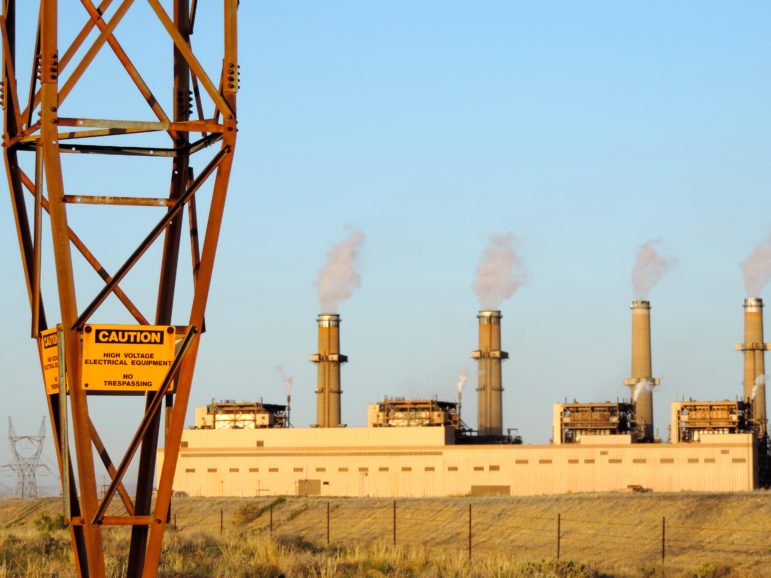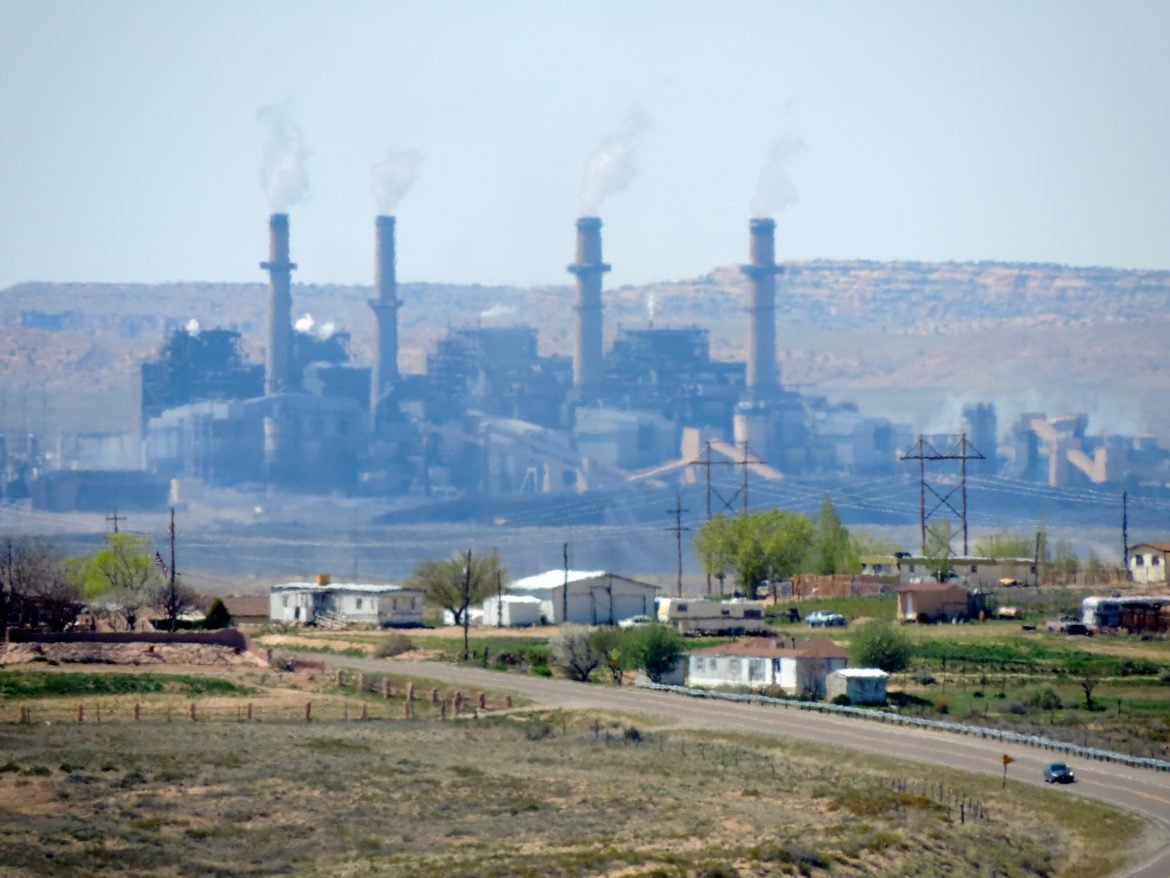It’s like cruising along in a refurbished airplane, which works well enough, but isn’t shiny anymore, then looking down at a new plane and deciding to jump out to ride in that one instead. And you’ve got all the parts in your hands to make a parachute, but you’ve got to put them together on the way down. That’s how one coal miner says the planned shut down of the San Juan Generating Station and its associated mine feels right now.
He was one of a trio of miners who drove the three and a half hours Thursday to tell lawmakers in Santa Fe not to forget their communities as the San Juan Generating Station is taken offline. Already, he’s transitioned his kids through a recent divorce, he told House Labor, Veterans and Military Affairs Committee members, and now he faces the end of his job sometime before the generating station shuts down in 2022 and the possibility of moving if he can’t find work. He’s doubtful his ex-wife’s job as a hairstylist would survive an economic downturn in their town.
Barry Dixon, the business manager of the International Union of Operating Engineers, which represents underground and surface miners, organized the visit to the Roundhouse for the coal miners and asked that they not be named.
Everyone works for the American dream: a house, a car, a boat, Dixon said, and if jobs leave the area, “How do you pick up all that and move?”
Closing the San Juan Generating Station in northwestern New Mexico, the longtime source of coal-fired power for the Public Service Company of New Mexico, would foreclose the path to that dream people have relied on since the 1970s. PNM announced plans to close the plant well before its anticipated decommissioning date of 2053, ostensibly because coal-fired power is no longer cost-effective. Nor will that plant allow PNM to comply with increased renewable power requirements lawmakers are contemplating.
The plant’s closure is expected to cost 450 jobs, with substantial ripple effects. San Juan County, San Juan Community College and the Central Consolidated School District are projected to lose nearly $9 million in property tax revenue.
On Saturday, lawmakers will discuss how to do the right thing for communities that stand in the crosshairs of changing how the state sources its electric power as they take up the Energy Transition Act, the state’s ambitious roadmap to a carbon-free future. Rep. Nathan Small, D-Las Cruces, one of the bill’s sponsors, said to do otherwise would not “honor the work that has gone on” in the towns that have long supplied much of New Mexico with electricity.
But the challenge is monumental. Already, the Farmington area has weathered unemployment rates at or above 10 percent in the last decade. Locals report a sluggish home market and friends underwater in their mortgages.
The aspiration is to replace hundreds of high-paying jobs in a short span of time in a region where economic opportunities are sparse. It’s like the miner said: It’s assembling a parachute after you’ve leapt from a traveling plane.
“There need to be some hard choices made on all levels on where we want to go,” said Bill McCamley, Department of Workforce Solutions secretary. “There’s got to be a target that everybody agrees on.”
The Department of Workforce Solutions will be hosting community meetings to determine what industries people hope to see grow. It’ll wait for the results of this session and gather public input before nailing down a plan, McCamley said.
The area is not without options: the film industry, reclaiming a Superfund site near Shiprock, establishing a rail line to export produce, expanding the community college. Another miner said he’d work whatever will pay a salary comparable to the six-figures he’s made for the last 10 years so he can provide for his family and save for his kids and grandkids.
Whether PNM replaces coal with a natural gas plant or goes all-in on solar, both see major job losses as they move from construction to maintenance. The hope is that budding economic diversification measures will have blossomed by the time construction jobs run their course. So far, in meetings run by Four Corners Economic Development and the San Juan Citizens Alliance, legislators have heard that outdoor recreation tops the list.
Dixon was skeptical. “We’re not a ski resort, we’re not Canyon de Chelly,” the 43-year veteran of the mines said. “How they’re going to come up with that, I don’t know.”
Economic development is a key talking point for the Energy Transition Act, SB 489, which bundles a requirement for 100 percent carbon-free power by 2045 with measures to support communities after the plant’s closure. The act will have its first committee hearing at 10 a.m. tomorrow at the Roundhouse before the Senate Conservation Committee.
Lawmakers seem to understand the stakes.
“We have a potentially catastrophic problem when the power plant ceases operation and goes into dismantlement,” said House Speaker Brian Egolf, D-Santa Fe.
In addition to the San Juan Generating Station, other coal-fired generating stations in the area are expected to close, and Egolf tallies a total hit of 2,500 direct jobs, and as many as 10,000 indirect jobs, plus the loss to the property tax base.
“It’s a multifaceted approach, and we hope that San Juan County and Farmington can be a leader that shows the rest of the United States how to transition out of a coal-dependent economy and into a more diversified economic base,” Egolf said of SB 489. “It’s not going to be easy, but we’re focused on getting it done.”
Should that behemoth of a bill fail, lawmakers from the region have a fallback in the Abandoned Utility Facilities and Funds Act, HB 498. It has measures similar to those in the Energy Transition Act. Both call for creating funds for economic development and displaced workers that help workers qualify for state or federal tax relief and enroll in retraining programs.
The Abandoned Utility Facilities and Funds Act also gives utilities one year to submit a plan for replacing coal-fired power plants with new power generation in the same school district. That measure is to compensate the Central Consolidated School District for the loss of $3.5 million annually in property tax revenue. The margins for these communities are slim, and Dixon said a cut to funding could mean closing a school or crowding classrooms.
“For decades, this region has relied on the coal power plant for jobs. … The ground is shifting under our feet,” Rep. Anthony Allison, D-Fruitland, said during a hearing on the bill, which he sponsored, by the House Labor, Veterans and Military Affairs Committee on Thursday. “This bill will not solve all of the economic issues facing the San Juan region, but it helps ensure the state is not leaving this area behind.”

Allison worked in a coal mine for 37 years before retiring in 2010, and has a son, son-in-law, and niece currently working at coal mines and power plants in the Four Corners area. His bill calls for assessing proposed power replacement systems for their economic impact — cost and the pay and benefits of their jobs — as well as environmental impacts and use of previously mined land. That last measure is a shot at a future in which the 18,000-acre San Juan Mine site is topped with solar panels, a rare option for reusing land filled with coal ash and mining waste. Utilities in other states have successfully transitioned even severely degraded coal properties into utility-scale solar plants, according to the U.S. Environmental Protection Agency.
But Rep. Rod Montoya, R-San Juan, said the Energy Transition Act’s tactics ignore the facts and fail to adequately plan for the human casualties of transitioning power sources.
“The better solution would be to have a glide path where we have more time to react. There is potential for other industries, but we’ve got to recruit them,” he said. “Another five years would allow us to respond, and that’s what we’re asking for.”
He also questioned who would hold the purse strings on the proposed economic development and displaced worker funds, and whether those measures might be “paternalistic.”
What everyone seems to have forgotten, a San Juan-area miner pointed out, is that already, two units of the San Juan Generating Station have been taken offline, costing jobs and depressing home values. Lawmakers still debating these measures, he said, are “waiting ’til the last minute to deal with an issue that should have been dealt with years ago.”
Another recalled having made this same kind of trip more than a year ago to testify to lawmakers. This time, she woke up early Thursday to make breakfast burritos and pack lunches for her kids to try to make up for missing one of her son’s games for the first time. The miners came to speak about HB 498 on Thursday, only to be encouraged to come back again to speak on SB 489 on Saturday. That would mean another seven hours in the car, and, for one miner, skipping his daughter’s birthday party. And for what outcome?
“Everyone keeps saying, ‘we want to help,’” one miner said, “But what are they doing?”
These meetings, they argued, should be held in the communities they affect, rather than asking those people to drive to Santa Fe.
Replacing coal power with a natural gas plant or a 450-megawatt solar photovoltaic array would each create abundant temporary jobs, but neither will fully replace the workforce or tax base. Kelly O’Donnell, an economist with O’Donnell Economics and Strategy hired to analyze the San Juan Generating Station shutdown, estimated the solar array would generate $9 million a year in tax revenue, matching the lost tax base — if it’s built on a scale that allows selling that power for export. But after employing thousands for construction jobs, it would need just 57 permanent employees to maintain it. She used the National Renewable Energy Laboratory’s Jobs and Economic Development Impact model for those estimates.
The hope is that a comprehensive economic development strategy will offer a safety net.
“Hopefully, the efforts driving in that direction will start to produce jobs at right about the time the construction jobs start to die off,” O’Donnell said. “It’s hard to say if those things will coincide perfectly.”
Nothing in the legislation mandates that the power plant installed in that area use renewable energy — and serious contemplation has been given to a natural gas plant as a substitute. O’Donnell’s research cautions about chasing short-term gains instead of long-term vision. Farmington has already launched an Outdoor Recreation Industry Initiative, and a switch to solar power would support those ambitions and their accompanying green ethos, while natural gas power would not.
It’s an echo of McCamley, with Workforce Solutions, who says everyone will need to be rowing in the same direction.
“This can’t be done by half measures,” O’Donnell said. “One of the primary concepts of economic development is that you want to capitalize on assets you have — what’s your comparative advantage? And the comparative advantage of the Four Corners region is, by and large, cultural and environmental assets. Up to now, they’ve leveraged their natural resources. I’d say, well, maybe it’s time to start leveraging a different set of natural resources.”
